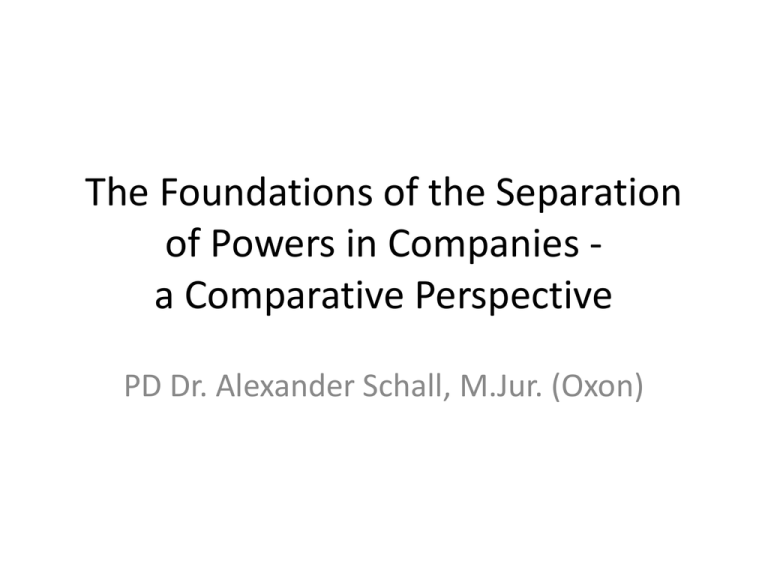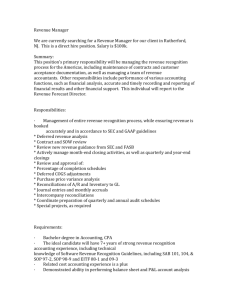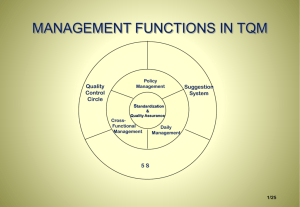Schall
advertisement

The Foundations of the Separation of Powers in Companies a Comparative Perspective PD Dr. Alexander Schall, M.Jur. (Oxon) The separation of powers (“SOP”) in companies • SOP in companies is based on dualism of organs: – Board (one-tier or two-tier) – General Meeting • Despite universality of SOP, actual situation in companies diverges – Large (listed) public companies: Autonomous management, investors reduced to control ›› real separation of ownership and control – Small private companies: shareholders as owner-operators ›› only formal separation of ownership and control • Search for foundations of SOP leads to origins of company law The origins of company law • Two basic role models for joint enterprises: – Partners on equal footing – Brain meets capital • Reflected for centuries in corresponding legal forms: – Partnership • Roman ‚societas‘ • Italian ‚compagnia‘ – Limited partnership • Roman ‘societas publicanorum‘ (eg tax collecting companies) and ‘peculium’ (kind of business trust for business of slaves or sons ) • 1408: Florentine ‚accomandita‘, derived from maritime trade (‘commenda’) • Cf. further the English trust The third way: Chartered companies facilitate „entrepreneur-agents“ • Corporate personality originates in the domain of public/church bodies (separation of office and office-holder). It is granted in particular by royal charters • Royal charters also confer monopolies on “trading companies”, organised as guilds, with the members trading on own account • Trading on joint account and under the name of the company begins with the East India companies in the Netherlands and in England (need to limit risks of long distance trade). • Development of “chartered companies”, administered by “governors”, as investment vehicle soliciting private investment (usually to fulfil public functions, like did the Roman societas publicanorum) • Result: Entrepreneurial agents enjoying wide autonomy in day-to-day running of the business because original principal (crown) often passive whereas investors barred from taking over complete control (one cannot buy “state power”) The success of the chartered companies and their imitators • Concept of chartered companies, in particular colonial companies, proves successful in principle – Thomas Smythe and the first clash of board and investors in the East India Company • The concept of chartered companies as investment vehicle spreads over Europe (e.g. France, Roman Empire) • Attempts to mimic structure by contractual imitations (to avoid discretion of grants by the crown) – Continent: limited partnership – England: deed of settlement companies (combined trust/partnership) • Downsides of contractual approach – No escape of personal liability for managers/trustees – No easy way to get rid of managers (partners!) The Death of the King • Demise of chartered companies from Mid of 18th century on • First corporate scandals (South Sea Bubble) • American and French Revolution • Chartered companies face „hard times“ on both sides of Atlantic • Concession system replaces charter system for stock corporations (in France, Germany and the US) – alternative of limited partnership with tradable shares remains attractive to avoid state control • Finally, the registration system prevails (starting 1844 in the UK) – the modern company is born The decline of SOP – rise of contract (I) • Code de Commerce (1807) recognises „société anonyme“ as third form next to partnership (‚en nom collectif‘) and limited partnership (en ‚commandite‘) • Common basis: contract of shareholders for joint purpose • Features: – – – – Legal personality (‚personne morale‘) Limited Liability of board and shareholders Supremacy of general meeting, board merely delegates Concession allows state control (step back from active governance) • Coins German stock corporations • Two investment vehicles co-exist: – Stock corporation (with shareholder supremacy) – Limited partnership “on stocks” (with management supremacy due to personal liability) The decline of SOP - rise of contract (II) • UK: – Joint Stock Corporations Act 1844: – Codified company (but not partnership/limited partnership) – no common legal basis for „societies“ – Features: • Separate legal personality • Limited liability only of board – shareholders as contributories (till 1855) • Supremacy of general meeting (e.g. right to interfere with management) • US: – Company as contract (Dartmouth College v. Woodward, 1819 – but see Dodge v. Woolsey, 1855: shareholders cannot overrule rights vested by Charter – Contractual freedom promoted by deregulation due to regulatory competition by end of 19th century The decline of SOP - emergence of private companies • Contractual freedom allows adaption of company model to smaller businesses – Few shareholders actually able to run company, e.g. via instructions or holding directorships – Owner-operator structures become common • From end of 19th century, company model extended to smaller enterprises – Germany: GmbHG 1892 – comes to France via Alsace-Lorraine – UK: Salomon Case, 1907 Act – US: Close corporations • SOP undermined by reunion of management and ownership The restoration of SOP • During first half of 20th century, SOP is restored in large companies • Mandatory and exclusive board competence to manage company – France: Arrêt Motte (1946) – US: Mason v Curtis (1918) – Germany: Aktiengesetz 1937 • See also UK: Automatic self-cleansing v Cunnighame (1906) - board competence as general rule, but subject to articles – Probably because capital market enforced SOP sufficently • Background: board supremacy corresponds actual situation, legal choice has no benefit but leads to uncertainty (investors) • New problems arise: “material transactions” by board Some observations • The legal personality of the company is still a mystery. This becomes immediately obvious beyond the black letter law: Long line of logical inconsistencies and ill-fitting analogies, e.g. – company as contract/partnership/trust; share as property – Mandatory SOP inconsistent with contractual basis of company and subordinated role of agents • Shareholders as supreme body of company, board as mere delegate • But: comprehensible from the “privilege perspective” (Dodge v. Woolsey) – Why should UK shareholders still dominate company after abolition of their liability? – Why were operators in private companies allowed to simply abolish SOP without loosing benefits of limited liability? • Constant difficulty to explain what happened to the King‘s governor after the King‘s death – reign of shareholder remains restricted • Company appears to be a privilege granted by the state, not a right to be recognised by the state (contrast freedom of contract) Conclusions: nature of company • Company is not a mere contract (or nexus of contracts), because neither separate legal personality and asset partitioning (entity shielding) nor limited liability (owner shielding) can be effected by contract – Privity of contract – no binding of third parties (principle of given, “natural” law) – State grant necessary • Consequence: Wide state discretion for shaping corporate governance structure (mandatory law, shareholder rule, board structure, permissible objects, stakeholder approach) Conclusions: SOP (I) • After decades of criticism (principal-agent-debate), the demand for the entrepreneur-agent displayed by the course of history underpins the virtues of SOP: – Freed from pressure by personal liability or pressing investors, agents are – like judges and civil servants – free to act for what they consider best for the company (positive attitude to freedom). – Well-working SOP prevents abuses of all kind (‘checks and balances’) and helps justifying the privilege of legal personality and limited liability. – The latter point is demonstrated by the fact that we discuss shadow director concepts, fiduciary duties of shareholders, minority oppression remedies, veil-piercing etc. as soon as shareholders overstep SOP by assuming managerial functions. Conclusions: SOP (II) • Shareholder supremacy is new threat to the entrepreneur-agent – Permanent performance pressure from the capital markets reduces managerial freedom – Shareholder value serves selfishness of the capital that may violate the common purpose of the company just as well as selfishness on the part of the agents – Concentration on capital interests is both one-sided (company as privilege at expense of third parties) and shortsighted (capital is not loyal). • Management fantasy diverts from business strategies to “financial doping” (e.g. leverage) Conclusions – SOP (III) • Law has to crown a new king, e.g. by: – Legal ban on pure shareholder value: • Mandatory ‘stakeholderism’ • Enlightened shareholder (sustainability) – Taking legal persons seriously: • The company has to be conducted as a “good merchant” (honesty, prudence, respect). It is not identical • All players bound to common corporate purpose by fiduciary duties (prohibits detrimental activity to shareholders - but: shareholder passivity is allowed) – Taming capital (markets) via unlimited liability for key financial institutions • shareholders closer to risk, thus cheapest cost avoider


